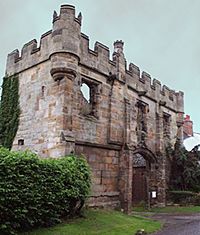Mackworth Castle facts for kids
Quick facts for kids Mackwoth Castle |
|
|---|---|
| Amber Valley, Derbyshire | |

The Grade I listed gatehouse of Mackworth Castle
|
|
| Coordinates | 52°56′13″N 1°32′07″W / 52.9369°N 1.5352°W |
| Official name: Mackworth medieval settlement including the castle gatehouse, part of the medieval open field system and a pinfold | |
| Designated: | 3 July 1933 |
| Reference #: | 1017258 |
|
Listed Building – Grade I
|
|
| Official name: Gatehouse to Mackworth Castle, Lower Road | |
| Designated: | 13 February 1967 |
| Reference #: | 1158635 |
Mackworth Castle was a building from the 1300s or 1400s in Derbyshire, England. It was located near Derby, in the village of Mackworth. For many centuries, it was the home of the Mackworth family. Today, only the ruins of its impressive gatehouse remain. This gatehouse suggests it was once a grand castle. However, a survey from 1911 hinted that the rest of the building might have been simpler. The ruins are now a protected historical site called a Scheduled Ancient Monument.
Contents
History of Mackworth Castle
When Was the Castle Built?
It's not completely clear exactly when Mackworth Castle was built. Experts believe it was constructed sometime between the early 1300s and the late 1400s. The Mackworth family, who owned the castle, can be traced back to the early 1400s.
The Mackworth Family Home
Mackworth Castle stayed in the Mackworth family for a very long time, until about 1655 or 1656. At that time, Sir Thomas Mackworth, 3rd Baronet, who had moved to a different place called Normanton, sold the castle. He sold it to Sir John Curzon, 1st Baronet.
A Castle in Decline?
There's a local story that the castle was destroyed during the Parliamentary Civil War. This war was a big conflict in England. The legend says the castle was hit by cannons from a nearby hill.
However, some historians wonder if the castle was already falling apart before it was sold to Sir John Curzon. For example, a historian named Rev. Charles Kerry pointed out something interesting. When Mary, Queen of Scots, was being moved by Sir Ralph Sadler in 1584, she wasn't brought to Mackworth Castle. Instead, she was taken to Tutbury. Sir Ralph Sadler explained to Queen Elizabeth that he couldn't find any suitable grand houses near Tutbury for the Queen of Scots to stay in. This suggests that Mackworth Castle might not have been a grand or suitable place for a queen even back then.
What Remains of the Castle
The Impressive Gatehouse
Today, the most important part of Mackworth Castle that still stands is its gatehouse. A gatehouse is like a fancy, strong entrance building to a castle. This one is square and has heavy battlements. Battlements are the parts on top of castle walls that look like teeth, used for defense. This gatehouse is so big and strong that it could almost be a separate building on its own.
Experts believe this gatehouse was added during the Tudor period, perhaps just before the year 1500. You can still see rectangular spaces on the west side of the gatehouse. These spaces were once courtyards, which are open areas surrounded by walls. The ruined gatehouse is considered a very important historical building and is a Grade I listed building.
Was It a Grand Castle?
According to Anthony Emery, a historian who studied medieval houses, Mackworth Castle might never have been extremely grand. A survey from 1911 suggested that the walls around the courtyards were probably made of "timber-framed on low rubble walls." This means they were wooden frames built on low stone foundations. This style was similar to another house nearby from the 1300s.
Emery believes that the gatehouse was mainly for show. It was built to look impressive and grand, like something from the age of knights and chivalry. This was a time when people started to miss the romantic idea of old castles, even if the rest of their homes weren't as grand.


